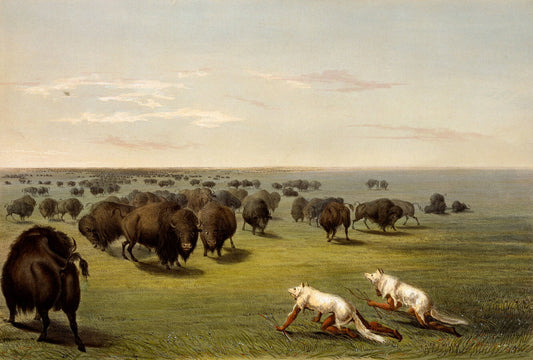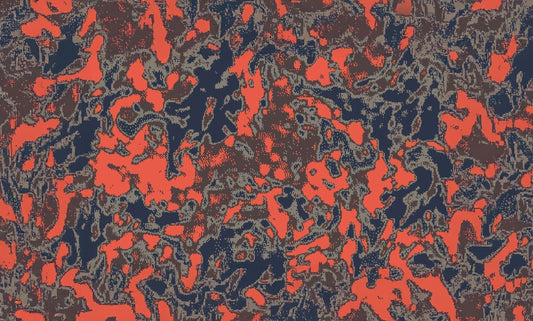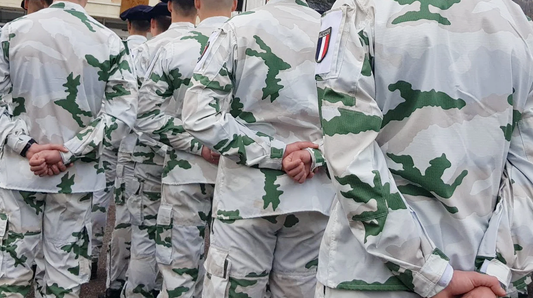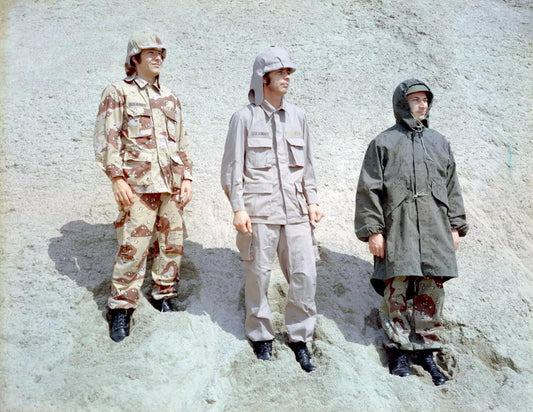Self-Decoration to Simulation
Kai CramerThe first true wearers of camouflage were hunters. Long before the concept was formalized, prehistoric humans learned to vanish into their surroundings to hunt and survive. They covered their bodies with mud, ash, and foliage to dull reflection and scent, masking their skin against the light and smell of the terrain. Many early hunters took this further, wearing the hides, feathers, or even skulls of animals they pursued. To them, disguise was not just strategy—it was transformation. By imitating an animal’s form, they believed they could channel its spirit, inheriting its instincts and power. Prehistoric cave paintings record these early acts of mimicry, proof that camouflage began as both survival technique and spiritual expression.

Two major styles of concealment emerged. The lone hunter perfected the art of invisibility, learning to stay motionless for hours, cloaked in leaves or hides, waiting for the smallest sign of movement. This was the birth of what soldiers centuries later would call fieldcraft—the discipline of merging completely with terrain. Group hunters developed a different skill set: dynamic concealment. They painted their bodies with bold stripes and irregular markings that broke up their shapes in motion, prefiguring the principle of disruptive coloration—used in 20th-century military camouflage to distort outlines and confuse the eye.
Across the world, these ideas took many forms. Plains tribes in North America wore wolf skins while stalking buffalo, both for camouflage and as a symbolic connection to the predator’s spirit. Artist George Catlin captured this in his paintings Buffalo Hunt under the Wolf-skin Mask (1832–33) and Catlin and His Indian Guide Approaching Buffalo under White Wolf Skins (c. 1846–48), where hunters draped in wolf pelts advance silently toward a herd. Arctic hunters wrapped themselves in white furs to blend into snow, while tropical hunters in the Amazon used fresh leaves and moss to blur their outline. Each culture used local materials and ecological knowledge to dissolve the boundary between human and habitat.
Centuries later, this ancient art evolved into specialized tools. Among the most famous is the ghillie suit, created by Scottish gamekeepers—known as ghillies—in the late 19th century. Originally a portable hide made from netting covered with irregular strips of burlap, twine, and cloth, it allowed hunters to become part of the landscape itself. The rough textures disrupted the human silhouette, creating a living mimic of the forest floor. As hunting practices influenced warfare, the ghillie suit was adopted by military snipers, who refined it with padding and ventilation to withstand long periods of stillness. Modern versions even incorporate heat-diffusing materials to reduce detection by thermal imaging systems.

Hunting’s influence on modern camouflage continued through the 20th century. In the early 1960s, when camouflage uniforms had temporarily fallen out of favor in the U.S. Army, American military advisors in Vietnam bought duck-hunting camouflage from civilian suppliers—borrowing directly from sporting gear. Then, in 1986, American hunter Bill Jordan launched Realtree, a groundbreaking line of naturalistic camouflage based on high-resolution overlays of real leaves, twigs, and bark. His patterns produced a three-dimensional illusion that revolutionized both hunting apparel and military textile design.
From the mud-smeared hunter on the plains to the digital camouflage prints of today, the lineage is continuous. Every innovation—whether a wolf pelt, a ghillie suit, or a modern photorealistic print—traces back to the same primal goal: to disappear into the landscape, not as artifice, but as instinct.



